Was There a U.S. Nuclear Weapons Accident At a Dutch Air Base? [no, it was training, see update below]
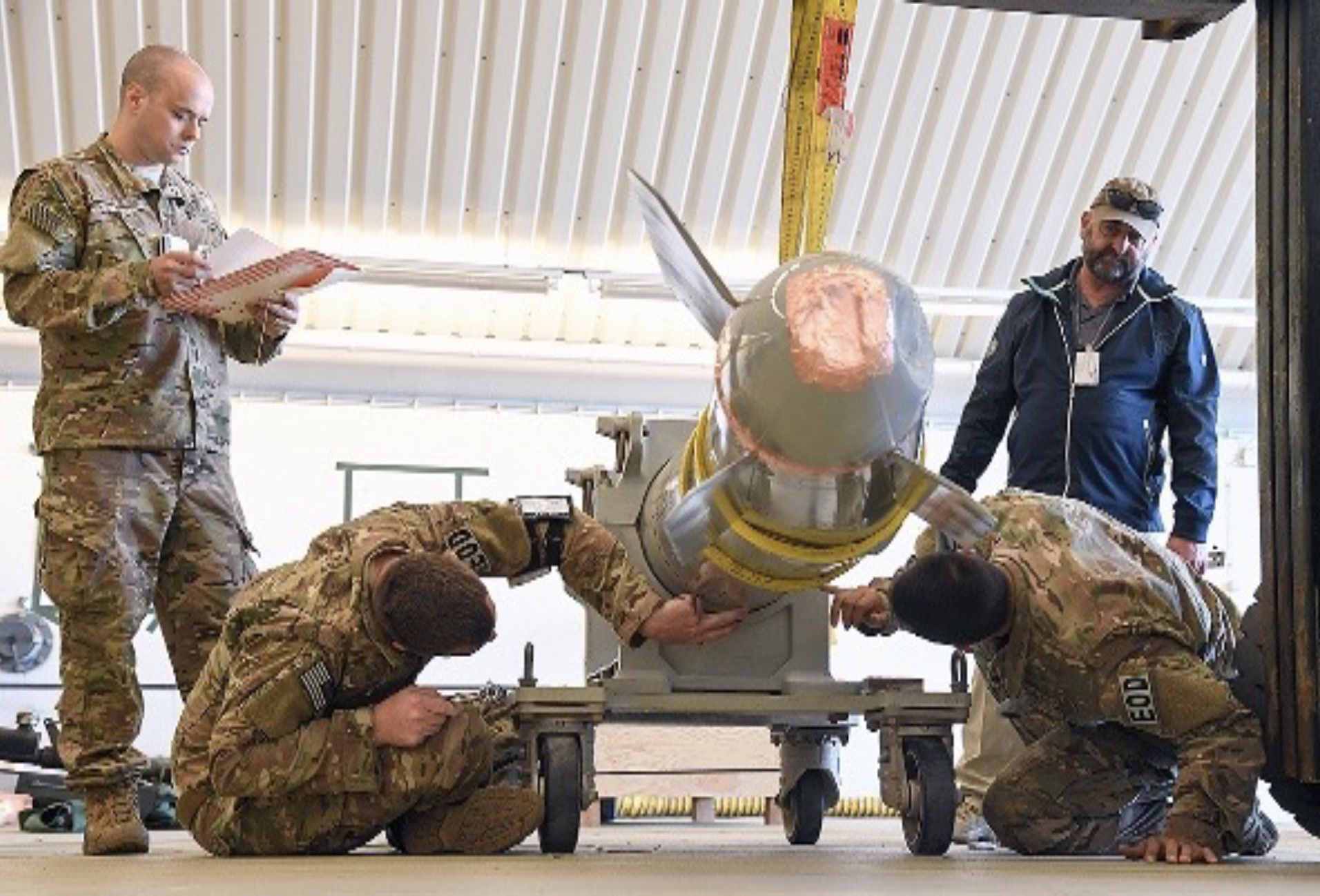
Did the U.S. Air Force suffer a nuclear weapons accident at Volkel Air Base?
Did the U.S. Air Force suffer a nuclear weapons accident at an airbase in Europe a few years back? [Update: After USAFE and LANL initially declined to comment on the picture, a Pentagon spokesperson later clarified that the image is not of an actual nuclear weapons accident but of a training exercise, as cautioned in the second paragraph below. The spokesperson declined to comment on the main conclusion of this article, however, that the image appears to be from inside an aircraft shelter at Volkel Air Base.]
A photo in a Los Alamos National Laboratory (LANL) student briefing from 2022 shows four people inspecting what appears to be a damaged B61 nuclear bomb. The document does not identify where the photo was taken or when, but it appears to be from inside a Protective Aircraft Shelter (PAS) at Volkel Air Base in the Netherlands.
It must be emphasized up front that there is no official confirmation that the image was taken at Volkel Air Base, that the bent B61 shape is a real weapon (versus a trainer), or that the damage was the result of an accident (versus a training simulation).
If the image is indeed from a nuclear weapons accident, it would constitute the first publicly known case of a recent nuclear weapons accident at an airbase in Europe.
Most people would describe a nuclear bomb getting bent as an accident, but U.S. Air Force terminology would likely categorize it as a Bent Spear incident, which is defined as “evident damage to a nuclear weapon or nuclear component that requires major rework, replacement, or examination or re-certification by the Department of Energy.” The U.S. Air Force reserves “accident” for events that involve the destruction or loss of a weapon.
It is not a secret that the U.S. Air Force deploys nuclear weapons in Europe, but it is a secret where they are deployed. Volkel Air Base has stored B61s for decades. I and others have provided ample documentation for this and two former Dutch prime ministers and a defense minister in 2013 even acknowledged the presence of the weapons. Volkel Air Base is one of six air bases in Europe where the U.S. Air Force currently deploys an estimated 100 B61 nuclear bombs in total.
The United States is modernizing its air-delivered nuclear arsenal including in Europe and Volkel and the other air bases in Europe are scheduled to receive the new B61-12 nuclear bomb in the near future.
Image Description
What does the image itself show? It appears to show a damaged B61 nuclear bomb shape strapped to a four-wheel trolly. The rear of the bomb curves significantly to the left and one of four tail fins is missing. There is also pink tape covering possible damage to the rear of the tail. The image first (to my knowledge) appeared in a Los Alamos National Laboratory student briefing published last year that among other topics described the mission of the Accident Response Group (ARG) to provide “world-wide support to the Department of Defense (DoD) in resolving incidents and accidents involving nuclear weapons or components in DoD custody at the time of the event.”

The personnel in the image also tell a story. The two individuals on the floor who appear to be inspecting the exterior damage on the weapon have shoulder pads with the letters EOD, indicating they probably are Explosive Ordnance Disposal personnel. According to the U.S. Air Force, “EOD members apply classified techniques and special procedures to lessen or totally remove the hazards created by the presence of unexploded ordnance. This includes conventional military ordnance, criminal and terrorist homemade items, and chemical, biological and nuclear weapons.”
The person to the left overseeing the operation appears to be holding a folder with red dotted color markings that are similar to color patterns seen on classified documents that have been declassified and released under the Freedom of Information Act (FOIA) (see image to the right). The civilian to the right is possibly from one of the nuclear weapons laboratories. Los Alamos and Sandia both produced components to the B61 bomb.
What caused the damage to the B61 shape is unknown, but it appears to have been a significant force. It could potentially have been hit by a vehicle or bent out of shape by the weapons elevator of the underground storage vault.
Photo Geolocation
There is nothing in the photo itself or the document in which it was published that identify the location, the weapon, when it happened, or what happened. I have searched for the photo in search engines but nothing comes up. However, other photos taken inside Protective Aircraft Shelters (PASs) at Volkel Air Base show features that appear to match those seen in the accident photo.
One of those photos is from April 2022 (the same month the Los Alamos briefing was published), when Dutch princess Catharina-Amalia visited Volkel Air Base and was taken on a flight in one of the F-16s. The Dutch Air Force commander highlighted the visit in a tweet that includes several photos, including one from inside an aircraft shelter. The photo shows the princess with Dutch air force officials including what appear to be the head of the Dutch air force and the commander of the nuclear-tasked 312th squadron at Volkel, an F-16 fighter-bomber, and part of the lid of an underground Weapons Storage System (WS3) vault built to store B61 nuclear bombs (see image below).
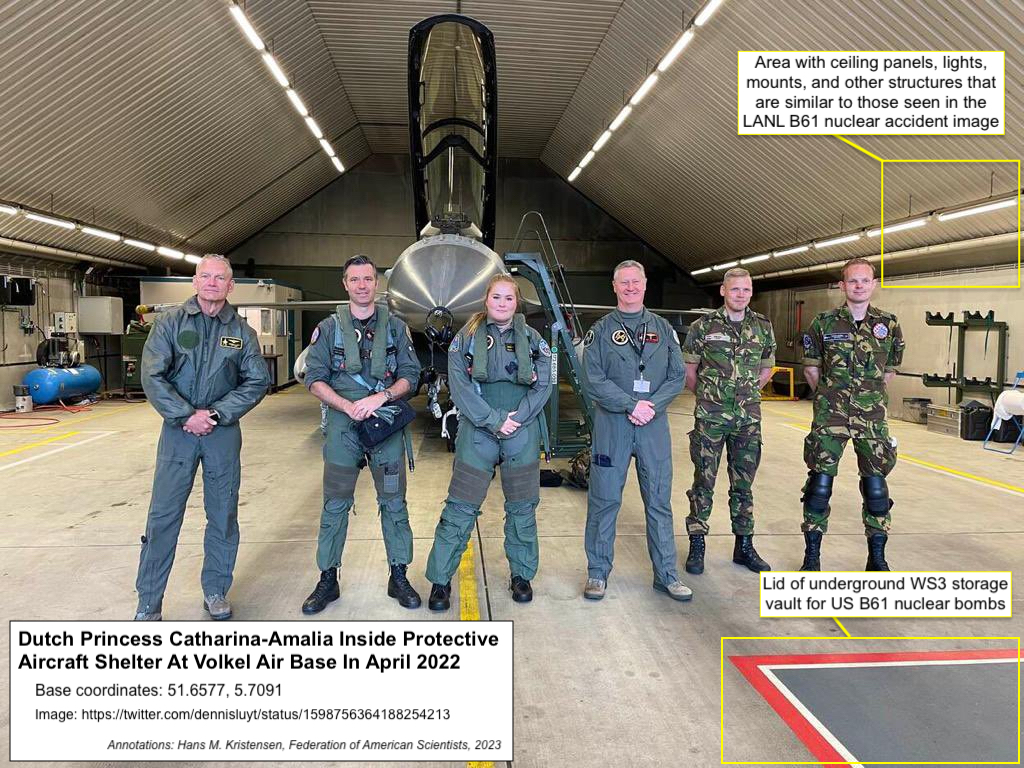
The 312th Squadron is part of the Dutch Air Force’s 1st Wing and is equipped with F-16 fighter-bombers with U.S.-supplied hardware and software that make them capable of delivering B61 nuclear bombs that the U.S. Air Force stores in vaults built underneath 11 of the shelters at the base. Dutch pilots receive training to deliver the weapons and the unit is inspected and certified by U.S. and NATO agencies to ensure that they have the skills to employ the bombs if necessary. In peacetime, the bombs are controlled by personnel from the U.S. Air Force’s 703rd Munition Support Squadron (MUNSS) at the base. If the U.S. military recommended using the weapons – and the U.S. president agreed and authorized use, the U.K. Prime Minister agreed as well, and NATO’s Nuclear Planning Group (NPG) approved – then the weapon would be loaded onto a Dutch F-16 and the strike carried out by a Dutch pilot. Such an operation was rehearsed by the Steadfast Noon exercise in October last year.
One of these pilots (presumably), the commander of the 312th squadron, appeared in a Dutch Air Force video published in February on the one-year anniversary of the (second) Russian invasion of Ukraine. In the video, the commander climbs into the F-16 and puts on his helmet. At first a visor cover can be seen showing an orange-yellow mushroom cloud illustrating a nuclear explosion. However, when the video cuts and the commander turns to face the camera, the nuclear mushroom cloud cover is gone, presumably to avoid sending the wrong message to Russia (see below). The nuclear mushroom visor cover was also seen during the NATO Steadfast Noon exercise at Volkel AB in 2011.
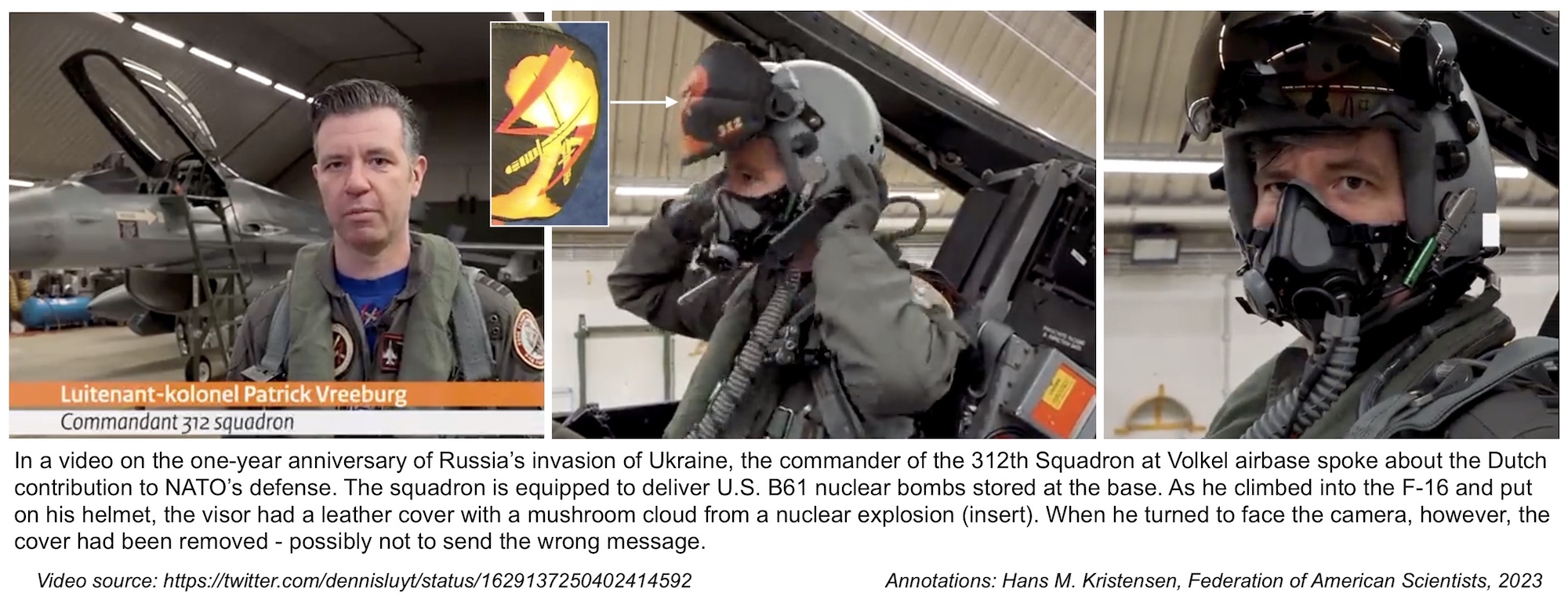
These pictures and videos show features that indicate the B61 nuclear bomb accident picture is from Volkel Air Base. Unlike aircraft shelters at other nuclear bases in Europe, the Dutch shelters have ceilings made up of three flat surfaces: the two sides and the top. The surfaces include unique light fixtures and meet the side walls with unique pipes and grids. Moreover, the shelter wall has a gray structure outline that is very similar to one seen in the video. These different matching features are highlighted in the image below.
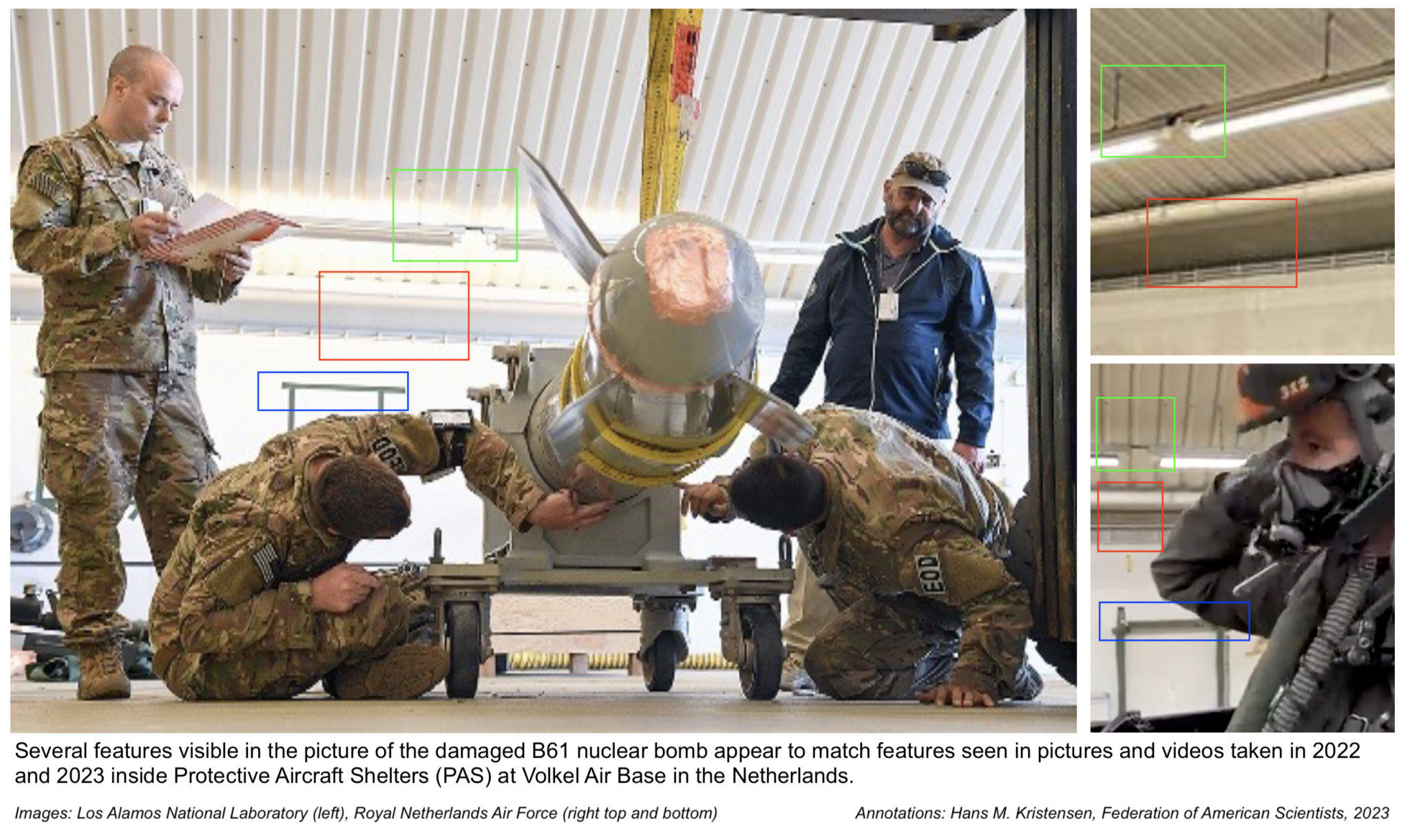
Nuclear Accident Management
Nuclear weapon designs such as the B61 are required to be “one-point safe,” which means the weapon must have a probability of less than one in one million of producing a nuclear yield if the chemical high explosives detonate from a single point. But if the weapon is not intact, such as during maintenance work inside a truck inside an aircraft shelter, a U.S. Air Force safety review discovered in 1997 – nearly three decades after the one-point safety requirement was established – that “nuclear detonation may occur” during a lightning storm. Improved lightning protection was quickly installed.
Management of accidents and incidents involving U.S. nuclear weapons at foreign bases is carried out in accordance with national and bilateral arrangements. The United States has held that the 1954 Status of Forces Agreement (SOFA) relating to the stationing of U.S. armed forces in the Netherlands was sufficient for regulating , but the Dutch government has been pressing for greater consultation in the Netherlands United States Operational Group (NUSOG), a special bilateral a coordinating body established to develop and manage U.S. nuclear weapons accident response plans, procedures, training, and exercises. Disclosure of a dispute in 2008-2009 once more confirmed the presence of nuclear weapons in the Netherlands.
Although nuclear detonation from an accident is unlikely, detonation of the chemical high explosives in the weapon would likely scatter plutonium and other radioactive materials. An accident inside a vault or shelter potentially would have local effect, while pollution from the crash of a C-17A cargo aircraft carrying several weapons could be a lot more extensive. A picture published by the Los Alamos National Laboratory in 2020 indicates that a single C-17A can carry at least 30 B61 nuclear bombs (see image below). That means that all the 10-15 B61 bombs estimated to be stored at Volkel Air Base could be moved in just one flight.
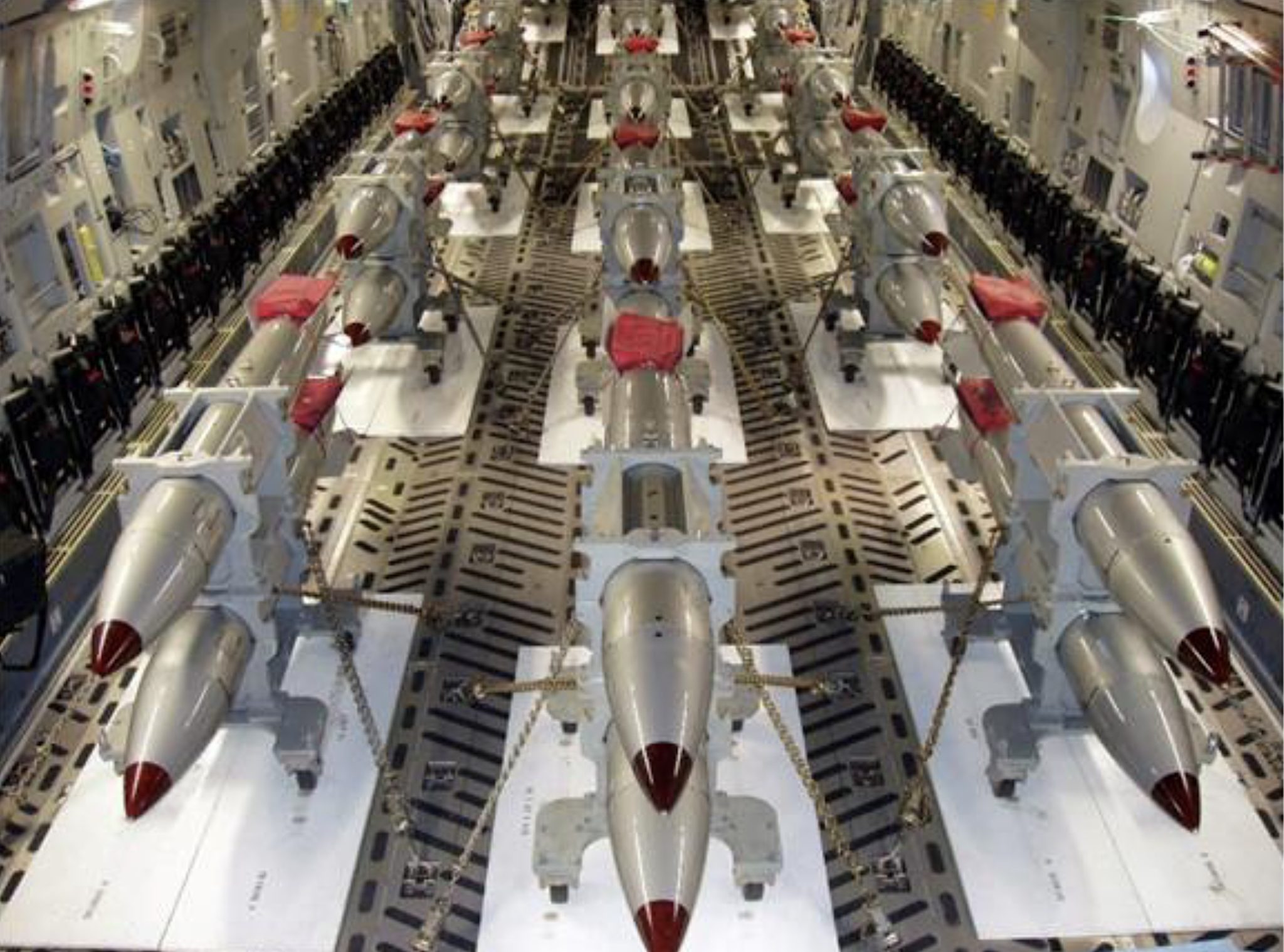
Background information:
FAS Nuclear Notebook: US Nuclear weapons, 2023
NATO Steadfast Noon Exercise and Nuclear Modernization in Europe
The C-17A Has Been Cleared To Transport B61-12 Nuclear Bomb To Europe
Lakenheath Air Base Added To Nuclear Weapons Storage Site Upgrades
This research was carried out with generous contributions from the John D. and Catherine T. MacArthur Foundation, the New-Land Foundation, Ploughshares Fund, the Prospect Hill Foundation, Longview Philanthropy, the Stewart R. Mott Foundation, the Future of Life Institute, Open Philanthropy, and individual donors.
While it is reasonable for governments to keep the most sensitive aspects of nuclear policies secret, the rights of their citizens to have access to general knowledge about these issues is equally valid so they may know about the consequences to themselves and their country.
Nearly one year after the Pentagon certified the Sentinel intercontinental ballistic missile program to continue after it incurred critical cost and schedule overruns, the new nuclear missile could once again be in trouble.
“The era of reductions in the number of nuclear weapons in the world, which had lasted since the end of the cold war, is coming to an end”
Without information, without factual information, you can’t act. You can’t relate to the world you live in. And so it’s super important for us to be able to monitor what’s happening around the world, analyze the material, and translate it into something that different audiences can understand.